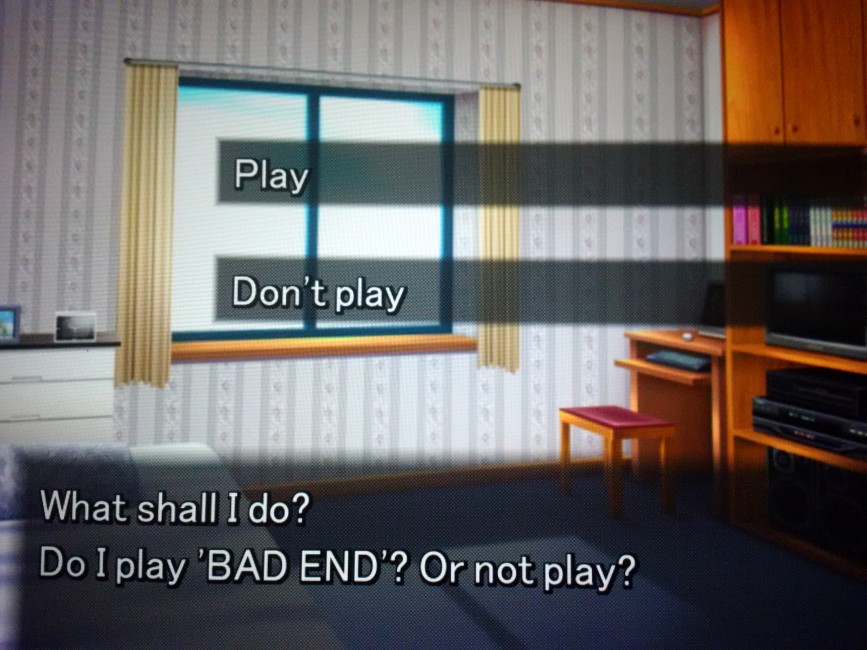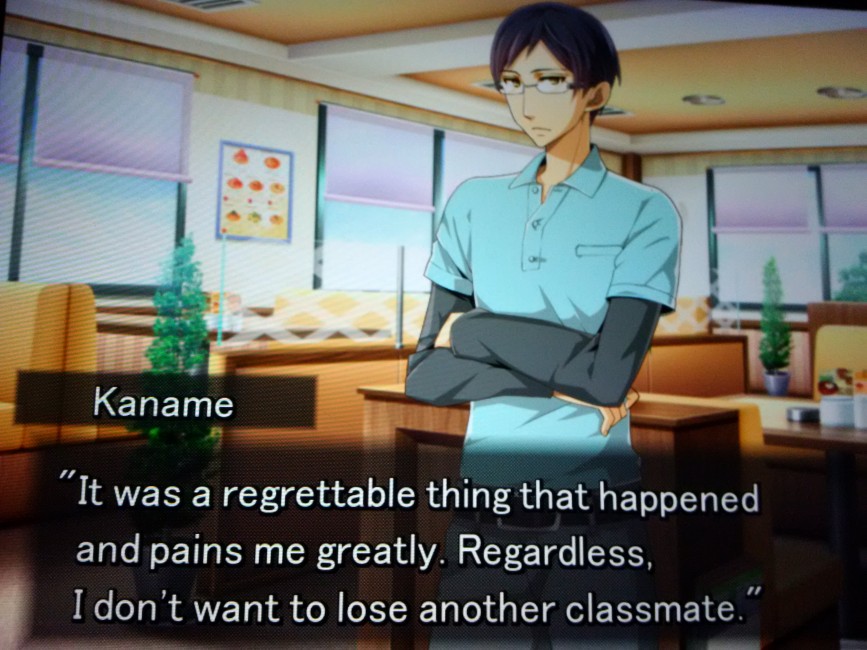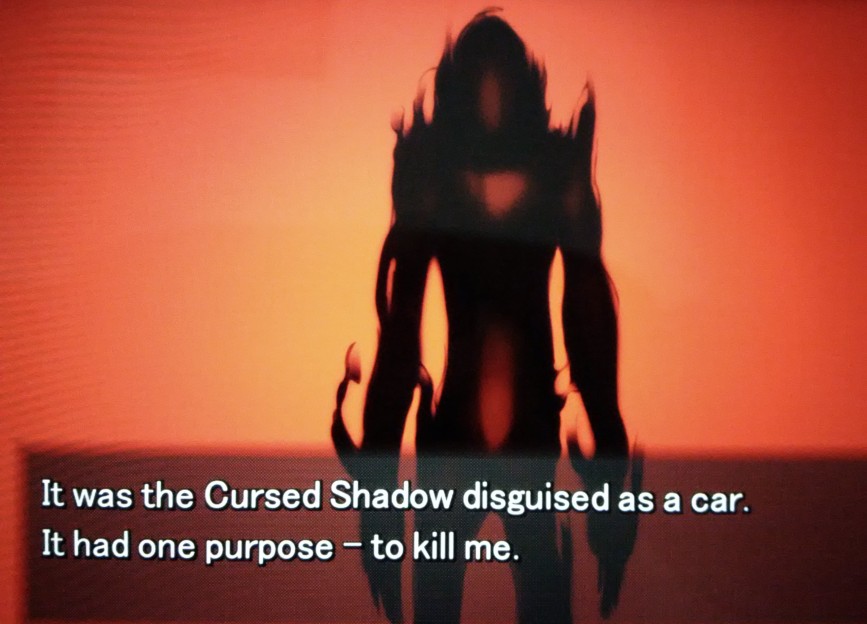For Halloween, I will review a little-known niche Japanese visual novel called “Bad End.” Bad End was developed by Arai Koh Create Office and published by YOX-Project. It is available for PC (via Steam), MacOS (10.10 or later), Android devices (Android OS 4.1 or later), and iOS devices (iOS 9.3 or later). If this review inspires you to give Bad End a go, you can find links to purchase the game in your preferred format on Bad End’s official website.
To start, this review will not spoil the story of Bad End, to the extent that the story could be spoiled. Furthermore, this is not an affiliate review, so The New Leaf Journal has no stake in whether you decide to purchase the game.
For this review, I played the Android version of Bad End on my Kindle Fire HDX – likely one of the more unusual formats to host the game. Although I have no reason to think that the version I played is materially different from the other ports of the game, my review only speaks for the version that I played.
- What is Bad End?
- General Big Spoiler Free Outline of Bad End
- Bad End Visual Novel Mechanics
- Writing and Translation Quality in Bad End Visual Novel
- Artwork and Music in the Bad End Visual Novel
- Length of the Bad End Visual Novel
- Overall Impressions of the Bad End Visual Novel
- How I Came Across Bad End
- Parting Shots
What is Bad End?

Game: Bad End
Developer: Arai Koh Create Office
Publisher: YOX-Project
Release: 2013 (JP); 2015 (US)
Genre: Visual Novel
Platforms: Android; iOS; PC (Steam)
Reviewed on: Kindle Fire HDX (Android)
Photo credit: Steam
Because I know many of our readers may not be familiar with visual novel games, I will start from the beginning.
A visual novel is a game told through pictures and text. Some visual novels are “kinetic,” meaning that the player does not interact with the game beyond reading the story. One visual novel that I recently discussed on site, Higurashi When They Cry, is an example of a kinetic visual novel. Other visual novels require input from the player, and the player’s choices affect the course of the story and ultimately how the story ends. Bad End falls into this latter category.
Bad End was first released for iOS devices in Japan in December 2013. As I will detail below, the game has a total of 13 endings, with the good “true ending” awaiting the player if he or she makes every key in-game choice correctly.
Note on Pictures in my Bad End Review
Regarding the pictures – please note that I used my phone to take pictures of my Kindle Fire screen during gameplay. Thus, the low quality pictures should not be held against the game, which I note later looks quite crisp.
General Big Spoiler Free Outline of Bad End
The player takes the role of Kyuuhei Inui, an ordinary Japanese high school student. His best friend, Yuuji Ogata, tells him about a rumored mobile game called “Bad End,” wherein the player dies in real life if he or she dies in the game. Yuuji manages to download Bad End, and he tells to Kyuuhei that he will provide his review the next day. Sadly, Yuuji did not live to offer his review like I did, leaving Kyuuhei to wonder whether the rumors about Bad End were actually true.
Kyuuhei manages to download Bad End and considers whether he should play it to determine if the game was the cause of his best friend’s death. This presents a choice for the game player. The player can choose for Kyuuhei to decline, leading to an early end of the game – but after having purchased Bad End, you may as well put Kyuuhei’s life on the line, no?

The “Bad End” game within Bad End tells the story of two ordinary high school girls, Kouko Iwasaki and Kana Mihashi. Kyuuhei finds, after a mundane start, that the girls’ circumstances were anything but ordinary, being that a murderous black shadow was stalking them.

At several junctures as the game continues, Kyuuhei must make a choice within “Bad End,” with one path leading to surviving and living to play another day, and the other paths leading to less pleasant outcomes – both in the game and in Kyuuhei’s real life.
To say more about the story would be to spoil too much of it, so I will refrain from doing so. Ultimately, by surviving in the game and making certain key decisions outside of the game, Kyuuhei gradually unravels the truth of “Bad End” the game, his best friend’s death, and the nexus between the real world and the game.
Bad End Visual Novel Mechanics
The vast majority of Bad End consists of reading dialogue. At times, most notably near the end of each game-play session of the in-game “Bad End,” the player will be confronted with a choice. For example, see the first game-within-the-game choice below.

With some exceptions, most in-game choices are decisive. That is, the “wrong” choice will lead to one of the game’s many “bad ends,” while the correct choice will allow the player to survive to advance. There are, however, a couple of special choices that do not bear fruit immediately.
The game provides many manual save slots for the player to save at key junctures in order to try different choices. One thing that I will credit the game for is its clever use of the auto-save function. After the very first save slot, the game makes periodic automatic save points, and I found while playing that the game automatically creates a new save point at every decisive choice. That way, even if the player accidentally (or intentionally) makes the wrong choice, he or she can immediately restore the game at the same choice menu and choose a different option to advance the story.
Regarding the choices themselves, of which I cannot say too much, one interesting thing I found is that a couple of early-game choices do not give the player much basis, if any, for choosing one option over another. For example, the choice pictured above in this section is random from the player’s perspective – there is no ground for choosing left, right, or straight. Over the course of the game, the choices begin to reward the player for paying attention to the story and making sense of subtle (and sometimes overt) clues. But some players may be frustrated in the early game with choices that require little more strategy than rolling the dice. Fortunately, the game’s autosave function makes guessing wrong painless. In another pleasant feature, the game also allows the player to create manual save points when choices are being offered.
Writing and Translation Quality in Bad End Visual Novel
Because Bad End was originally released in Japan, English-readers must play a translated version. While there are few outright typos, the translation is, to be charitable, clunky. The translation’s issues show up clearly in dialogue, where the way the characters talk to each other does not bear a striking resemblance to ordinary speech.

In another instance, a translation of one of the many in game bad endings was turned into accidental comedy by some questionable translation choices.

Bad End’s translation is a far cry (pun intended) from games such as Higurashi or Persona 4, both of which portray natural conversations and nuanced themes in a sophisticated way. With that being said, however, Bad End’s translation is adequate on the whole. For all of its awkwardness, I was never at a loss of what to do or unclear about what was happening. Even where in one important flashback scene in the later game the translation makes it difficult to follow the nuances of the conversation, the surrounding context clarifies the situation. Furthermore, there are visual novels with more significant translation issues – for example see the Chinese visual novel, Gaokao Love: 100 Days, which had a clever concept marred by a translation that made me wonder at times whether it translated each Chinese word into English individually (note: I last played Gaokao in 2017, so I am not accounting for any updates that may have been added since then). Bad End is entirely playable.
Artwork and Music in the Bad End Visual Novel
The game’s artwork is simple but effective. While the backgrounds look indistinguishable from many other visual novels, they are clean and give the player a clear idea of where a scene is taking place – whether it is at a school, in a park, in a character’s home, or at a diner.
The character designs are all solid. Kyuuhei remarks while playing Bad End that Kouko is pretty, and her character design portrays that. Kaname Sasaki, a relatively minor character, has a design that portrays his seriousness (see above). In fact, the character designs are the strongest part of the game’s aesthetics. Each of the characters has a school uniform sprite and a casual clothing sprite, along with a sufficient suite of expressions for all of the game’s needs and purposes.

There is little to be said about the game’s soundtrack and music. It is inoffensive and not memorable. The lack of good sound effects is a bit disappointing for what is supposed to be a horror visual novel. Unsurprisingly, the game does not have voice acting.
Extras in the Bad End Visual Novel
Speaking only for the Kindle version, the game includes a CG gallery for all the characters and access to the full soundtrack. Given the small scope of the game, these extras are adequate. There should be a gallery for the endings as well, but that is a minor quibble.
Length of the Bad End Visual Novel
Bad End is a relatively short game that can probably be completed within 2 hours by quick readers. One can add a bit of time to the game by also intentionally triggering all of the bad endings. Since the bad ends function like off-ramps from the main story, however, usually leading to a single short scene, going for 100% completion does not add much time to the adventure.
Overall Impressions of the Bad End Visual Novel
Bad End’s story errs on the formulaic side. The writing, through the translation, borders on adequate, but it does not do an effective job of making the player care strongly about the dramatic personae. The twists later in the story are somewhat clever, but neither surprising nor fully explained. Insofar as the game is a horror visual novel, it is lacking in horror. The game does not produce much of a sense of dread, much less jump scares.
However, if one goes into Bad End with proper expectations, it is not a bad way to kill an evening. While there is nothing profound or particularly novel, the survive-and-advance choice structure is mostly well done, save for the choices early in the game that require blind guessing (however, one could argue that even this makes some sense in the context of the story). The game is short and resists overstaying its welcome, allowing players to see everything there is to see in one or two sittings. There is enough there to justify the price for fans of the genre when it is less than $2. Despite the myriad shortcomings in the writing and story, the game does offer a satisfying conclusion for the main cast.
In conclusion, so long as one goes into Bad End knowing what it is and what it is not, it offers an interesting and niche visual novel experience. That it is available for a variety of devices, including some that are not exactly swimming in visual novel choices, is another feather in its cap.
How I Came Across Bad End
At the top of the review, I noted that I reviewed Bad End on my Kindle Fire HDX. My Kindle is turning 7 this Christmas, and it is so old that Amazon dropped the HDX line several years ago. I must also add that Bad End is no longer available from the Amazon app store for the Kindle Fire HDX, although it is available on the Google Play Store for most Android devices.
In 2015, I saw Bad End in the Amazon app store for a low price and decided to give it a try. I recall my impression of the game then being similar to what it is now.
I had mostly forgotten about Bad End until I was reorganizing my Kindle, having discovered the F-Droid application repository. Now that I have The New Leaf Journal to post new content, I thought that Bad End, being little known, would make an interesting review topic for Halloween.
I completed my second playthrough of the game this morning (October 31, 2020) after playing it over the course of two days. While I remembered the general outline of the story, I forgot the main twist that comes later, so it felt fresh enough.
Finally, I doubt that there are too many Kindle visual novel reviews floating around, so consider this my contribution to a very niche video game review category.
Parting Shots
I hope you enjoyed my look at a relatively obscure visual novel. Feel free to share your thoughts via our Contact Page or Hypothes.is if you decide to try Bad End. (Of course, you will have to avoid the bad endings to live to share your impressions – or so I read.) 10/29/22 Update: Updated contact links.